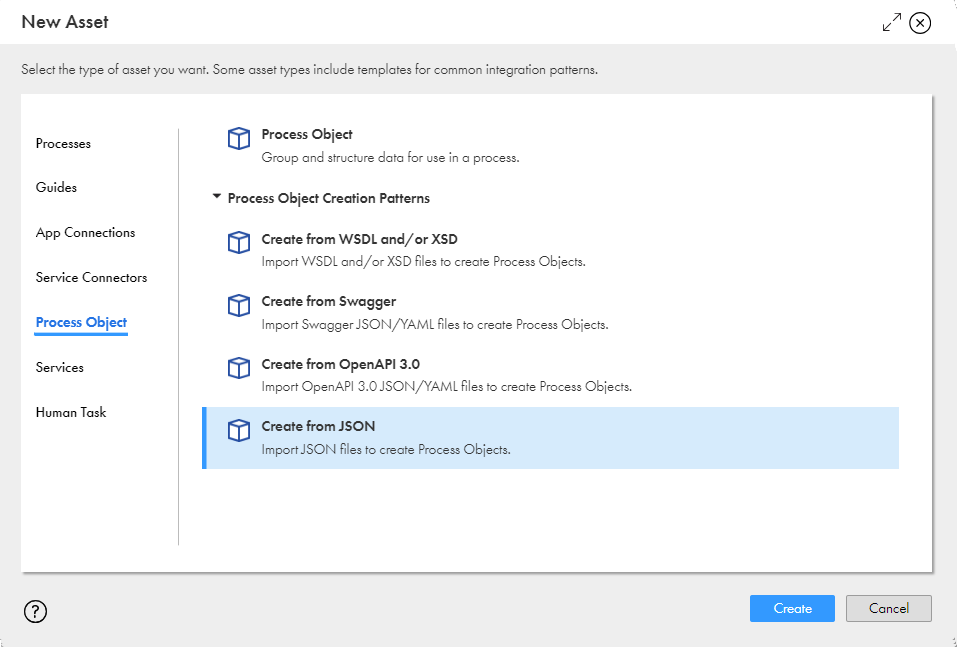Application Integration
- Application Integration
- All Products



Option | Description |
|---|---|
File | Select
File to specify a single JSON source file with payload from your local system. You can also specify HTTP resources. Click
Choose File to select the JSON source file.
The maximum allowed file size for a single file is 5 MB. To increase the maximum size
limit, contact Informatica Global Customer Support. Default is
File .
|
Zip (multiple files) | Select Zip to specify multiple JSON files that contain samples of
payloads to be received or returned by the process in the form of a zip
file from your local system. Click Choose File to
select the zip file. The maximum allowed file size for a zip file is
5 MB. To increase the maximum size limit, contact Informatica Global
Customer Support. |
URL | Select
URL to specify a URL that contains an JSON source file with payload. The
URL and
Use Authentication fields appear.
In the
URL field, enter the source URL.
Select the
Use Authentication option to specify the user name and password to access the source URL.
|
Direct | Select
Direct to create a process object by directly pasting a JSON payload. After you select the option, provide a unique process object name in the
Process Object Name field and paste the JSON payload in the text box.
The maximum allowed size for the JSON payload is 5 MB.
The
Process Object Name field and the text box can't be empty. The name that you provide in the
Process Object Name field must start with a letter and can contain only letters, numbers, underscores (_), and hyphens (-).
|

Column Name
| Description
|
|---|---|
File Name
| The file name of the resource.
|
File Path
| The URL or relative location of each resource within the source.
|
Type
| The file type of the resource. Displays the value as
JSON .
|
Status
| The status of the resource. Displays one of the following values:
|
Comments
| Indicates whether the file type is supported or not.
|

Column Name
| Description
|
|---|---|
Schemas
| The name of the generated XSD schema file.
|
Source
| The source from which the XSD schema file was generated.
|
Complex Types
| The number of complex types that will be created for each XSD schema.
|
Prefixes
| The prefix to be used for the XSD schema.
You can use a prefix to easily identify process objects that are created from a schema. For example, you might want to add the prefix
Salesforce for all process objects that are created from a Salesforce schema.
To specify a prefix for a schema, double-click under the
Prefixes column against the row that contains the schema, and enter a prefix. All the process objects that are created from the schema will use the same prefix that you specify in this field.
|
Tags
| The tags to be used for the XSD schema.
You can use a tag to group related schemas together. For example, you might want to group all schemas containing financial resources under the tag
Finance .
To specify a tag for a schema, double-click under the
Tags column against the row that contains the schema, and enter a tag. All the process objects that are created from the schema will use the same prefix that you specify in this field.
|

Column Name
| Description
|
|---|---|
Name
| The name of the process object that was generated from the schema.
|
Description
| The schema from which the process object was generated. You can edit the description.
|
No. of Fields
| The number of complex types that the process object contains.
|
Tags
| The tags to be used for the process object. By default, the process object tags are derived from the tags that you specified for the XSD schema.
You can edit the tags if you want to specify different tags at the process object level.
To edit the tags for a process object, double-click under the
Tags column against the row that contains the process object, and update the tags.
|


